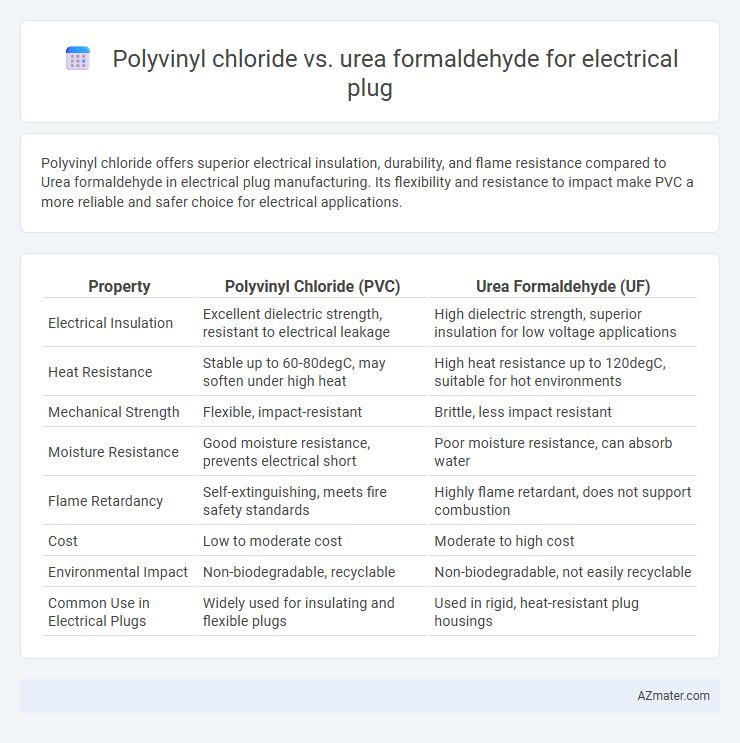Polyvinyl chloride offers superior electrical insulation, durability, and flame resistance compared to Urea formaldehyde in electrical plug manufacturing. Its flexibility and resistance to impact make PVC a more reliable and safer choice for electrical applications.
Table of Comparison
| Property | Polyvinyl Chloride (PVC) | Urea Formaldehyde (UF) |
|---|---|---|
| Electrical Insulation | Excellent dielectric strength, resistant to electrical leakage | High dielectric strength, superior insulation for low voltage applications |
| Heat Resistance | Stable up to 60-80degC, may soften under high heat | High heat resistance up to 120degC, suitable for hot environments |
| Mechanical Strength | Flexible, impact-resistant | Brittle, less impact resistant |
| Moisture Resistance | Good moisture resistance, prevents electrical short | Poor moisture resistance, can absorb water |
| Flame Retardancy | Self-extinguishing, meets fire safety standards | Highly flame retardant, does not support combustion |
| Cost | Low to moderate cost | Moderate to high cost |
| Environmental Impact | Non-biodegradable, recyclable | Non-biodegradable, not easily recyclable |
| Common Use in Electrical Plugs | Widely used for insulating and flexible plugs | Used in rigid, heat-resistant plug housings |
Introduction: Choosing Materials for Electrical Plugs
Polyvinyl chloride (PVC) offers excellent electrical insulation, flame resistance, and durability, making it a preferred material for electrical plug casings. Urea formaldehyde provides superior rigidity and heat resistance but has limitations such as brittleness and potential formaldehyde emissions, impacting safety considerations. Selecting between PVC and urea formaldehyde involves evaluating factors like thermal stability, electrical insulation properties, mechanical strength, and environmental safety for optimal plug performance.
Overview of Polyvinyl Chloride (PVC)
Polyvinyl chloride (PVC) is a widely used thermoplastic polymer known for its excellent electrical insulation, chemical resistance, and durability, making it ideal for electrical plugs. PVC's high dielectric strength and flame-retardant properties ensure safety and longevity in electrical applications, outperforming urea formaldehyde in terms of flexibility and impact resistance. Its cost-effectiveness and ease of molding contribute to its dominance in manufacturing electrical components like plugs and sockets.
Overview of Urea Formaldehyde (UF)
Urea Formaldehyde (UF) resin is a thermosetting polymer widely used in electrical plugs due to its excellent electrical insulation properties, high mechanical strength, and heat resistance. UF offers superior dimensional stability and low moisture absorption compared to Polyvinyl Chloride (PVC), making it ideal for components exposed to high temperatures and electrical stress. Its rigid structure also provides enhanced durability and flame retardance, critical for ensuring safety in electrical applications.
Physical Properties Comparison
Polyvinyl chloride (PVC) offers high impact resistance, excellent flame retardancy, and good insulation properties, making it suitable for electrical plugs exposed to mechanical stress and heat. Urea formaldehyde exhibits superior hardness and dimensional stability but is more brittle and less impact-resistant compared to PVC. PVC's flexibility and chemical resistance provide better durability in dynamic environments, whereas urea formaldehyde's rigidity limits its use to applications requiring rigid and heat-resistant materials.
Mechanical Strength and Durability
Polyvinyl chloride (PVC) exhibits superior mechanical strength and durability compared to urea formaldehyde when used in electrical plugs, offering enhanced impact resistance and flexibility under stress. PVC's resilience to deformation and better moisture resistance contribute to a longer lifespan and reduced risk of cracking in electrical components. Urea formaldehyde, while rigid and heat-resistant, tends to be more brittle and prone to mechanical failure under repeated mechanical stress.
Electrical Insulation Performance
Polyvinyl chloride (PVC) offers superior electrical insulation performance due to its high dielectric strength and resistance to moisture, making it ideal for electrical plug applications. Urea formaldehyde exhibits excellent electrical insulating properties with high mechanical strength but is more brittle and less resistant to heat and moisture compared to PVC. PVC's enhanced durability and flexibility ensure reliable insulation under varying environmental conditions in electrical plugs.
Heat and Fire Resistance
Polyvinyl chloride (PVC) exhibits superior heat and fire resistance compared to urea formaldehyde, making it a safer choice for electrical plugs. PVC maintains stability at temperatures up to 140degC and has self-extinguishing properties, reducing the risk of fire hazards. In contrast, urea formaldehyde has lower thermal resistance and can degrade or ignite under prolonged heat exposure, compromising electrical safety.
Safety and Regulatory Compliance
Polyvinyl chloride (PVC) offers superior electrical insulation, flame retardance, and resistance to environmental degradation, making it highly compliant with international safety standards such as UL 94 and IEC 60695 for electrical plugs. Urea formaldehyde, while providing good mechanical strength and heat resistance, poses concerns due to formaldehyde emissions and lower flame retardancy, potentially limiting its regulatory acceptance in consumer electrical components. PVC's stability under electrical stress and stringent adherence to RoHS and REACH regulations make it the preferred material for safer, regulatory-compliant electrical plugs.
Environmental Impact and Sustainability
Polyvinyl chloride (PVC) used in electrical plugs poses significant environmental concerns due to its release of toxic dioxins during production and disposal, contributing to pollution and hazardous waste issues. Urea formaldehyde, while less harmful in terms of persistent organic pollutants, releases formaldehyde gas, a volatile organic compound with health risks and environmental implications. Sustainable alternatives prioritize materials with low toxicity, recyclability, and minimal emissions over their life cycle, making PVC less favorable compared to more eco-friendly formulations or bio-based resins.
Cost Analysis and Industry Applications
Polyvinyl chloride (PVC) offers a cost-effective solution for electrical plugs with its low material and processing expenses, making it widely used in consumer electronics and household wiring applications. Urea formaldehyde, though more expensive due to its superior heat resistance and electrical insulation properties, is favored in high-performance industrial electrical connectors and appliances requiring enhanced durability. Industry adoption of PVC dominates mass-produced electrical plugs, while urea formaldehyde is preferred in niche markets demanding higher safety standards.

Infographic: Polyvinyl chloride vs Urea formaldehyde for Electrical plug
 azmater.com
azmater.com